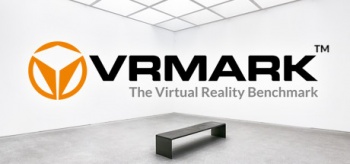VRMark
| VRMark | |
|---|---|

| |
| Information | |
| VR/AR | VR |
| Developer | Futuremark |
| Publisher | Futuremark |
| Platform | SteamVR, Oculus Rift (Platform) |
| Device | HTC Vive, Oculus Rift |
| Operating System | Windows |
| Type | Software |
| Genre | Utilities, VR, Benchmark |
| Input Device | Keyboard / Mouse |
| Play Area | Seated, Standing, Room-Scale |
| Language | English, German, Russian, Simplified Chinese |
| Review | Mixed |
| Release Date | Nov 3, 2016 |
| Price | $19.99 |
| App Store | Steam |
| Website | http://www.futuremark.com/benchmarks/vrmark |
| Infobox Updated | 11/21/2016 |
Contents
Review
Introduction
VRMark is being developed by Futuremark, the company that created the famous 3DMark – a graphics benchmarking utility that not only benchmarks computers but even notebooks, laptops, smartphones, tablets and high-end gaming machines. VRMark is the first VR benchmarking application. It is primarily focused on measuring a user’s system’s performance and ability to run modern HMDs. In addition, the software is also aimed to be used by reviewers to measure the latency of HMDs. The software is in development stages at the moment and is planned to be released during 2016. However, not all of the software will be released to the public [1].
Current Version
A Holiday Beta version of VRMark is available for free on the Steam Store but it requires the user to have the base application 3DMark installed in order to run. The Holiday Beta version of the software does not provide a score at the end of its run and is for entertainment purposes only. The software does not require a HMD to operate and can function on the user’s computer monitor too. The user can roam freely in the VRMark’s test environments. There are around four classic 3DMark scenes available in VR for Oculus Rift and HTC Vive [2].
The Holiday Beta version does not provide a score but ultimately measures the rank of a system on graphical powers, latency and accuracy. The latter two factors are extremely important to deliver a good VR experience and also prevent motion sickness.
Features
VRMark is designed for press, analysts and manufacturers and utilizes a combination of software and hardware to measure the system’s VR performance. It tests the system’s performance and ability to deliver high quality Virtual Reality experiences for photos, games, simulations and videos.
VRMark is meant to develop new standards and certifications to ensure the health and well-being of VR users. It is created by programmers and coders with industrial experience to ensure the best VR experience for users. VRMark has the ability to measure four different latency events:
- Time from physical event to API event
- Time from API event to draw call
- Time from draw call to image on display
- Total latency.
Futuremark has revealed that the 3rd step of testing will not be available to general public and it requires some specialized equipment for proper testing and execution [3].
About the Company
VRMark is a product of Futuremark, a Finnish software development company located in Espoo, Finland. Futuremark became a part of UL, a global safety science organization in 2014 and VRMark is the first product of the two companies together.
Description
Is your PC ready for VR? Find out with VRMark, the virtual reality benchmark.
- See if your PC meets the performance requirements for HTC Vive and Oculus Rift.
- Test your PC with two VR benchmark tests, headset not required.
- Or connect an HMD and judge the VR experience with your own eyes.
- Detailed results and hardware monitoring charts.
- Explore each scene in VR or on your monitor with Experience mode.
Try before you buy
The performance requirements for VR games are much higher than for typical PC games. So before you buy an HTC Vive or Oculus Rift, use VRMark to see whether your PC has what it takes to deliver a great VR experience.
VRMark includes two benchmark tests that run on your desktop monitor, no headset required. Or connect an HMD and see for yourself with the free-roaming Experience mode.
Orange Room benchmark
The VRMark Orange Room benchmark shows the impressive level of detail that can be achieved on a PC that meets the recommended minimum hardware requirements for HTC Vive and Oculus Rift. If your PC passes this test, it's ready for the two most popular VR systems available today
Blue Room benchmark
The VRMark Blue Room benchmark is a more demanding test with a greater level of detail for use with future hardware generations. A PC that passes this test is ready to run the latest VR games on the HTC Vive and Oculus Rift at the highest settings
Results and reporting
After running each test, you'll see clearly whether your PC has passed or not. You'll get an overall score for your PC, which you can use to compare systems, and detailed charts showing how your PC performed during the test.
Experience mode
VR headsets use clever techniques to compensate for missed frames. With Experience mode, you can judge the quality of the VR experience with your own eyes. Explore each scene in your own time in VR or on your monitor.
Features
System Requirements
Windows
Minimum
- OS: Windows 7 (64-bit) with Service Pack 1
- Processor: Dual core CPU with SSE 4.1 support
- Memory: 2 GB RAM
- Graphics: 1.5 GB video card memory
- Storage: 2 GB available space
Setup Instructions
The VR mode for this game requires the use of a keyboard and mouse.
Images and Videos
References
- ↑ http://www.tomshardware.com/news/vrmark-virtual-reality-benchmark-preview,30820.html
- ↑ http://www.digitaltrends.com/virtual-reality/3dmark-holiday-2016-beta/
- ↑ https://www.futuremark.com/benchmarks/vrmark